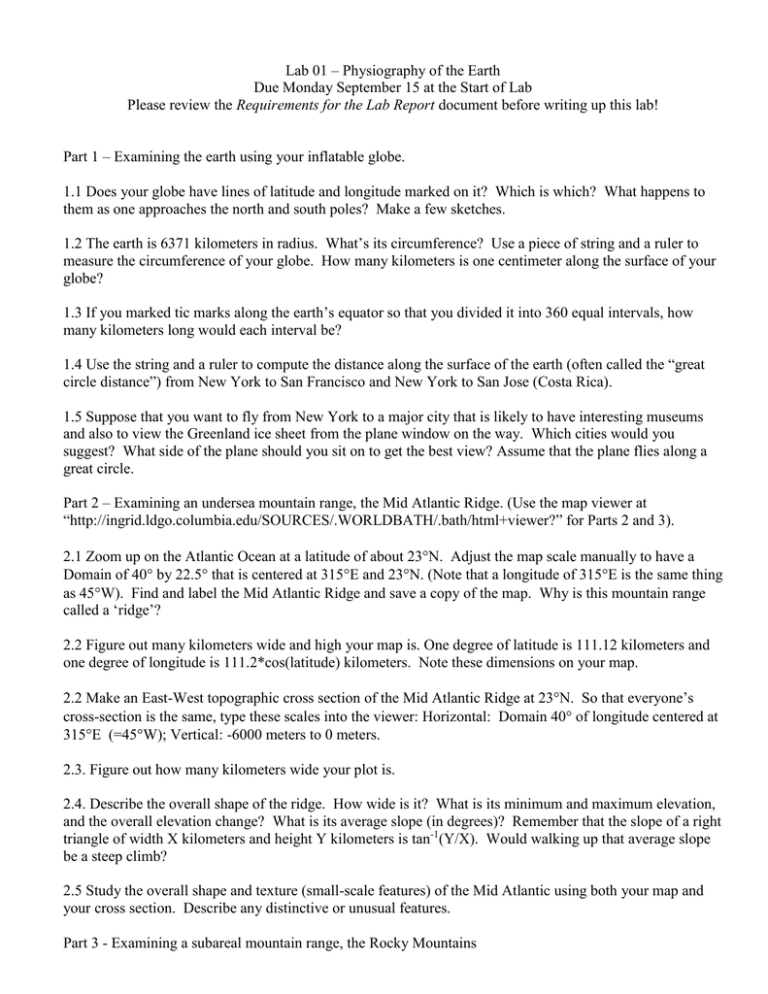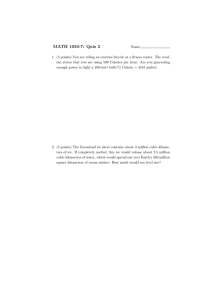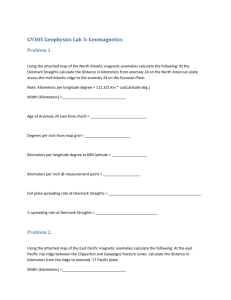Lab 1: Physiography of the Earth
advertisement

Lab 01 – Physiography of the Earth Due Monday September 15 at the Start of Lab Please review the Requirements for the Lab Report document before writing up this lab! Part 1 – Examining the earth using your inflatable globe. 1.1 Does your globe have lines of latitude and longitude marked on it? Which is which? What happens to them as one approaches the north and south poles? Make a few sketches. 1.2 The earth is 6371 kilometers in radius. What’s its circumference? Use a piece of string and a ruler to measure the circumference of your globe. How many kilometers is one centimeter along the surface of your globe? 1.3 If you marked tic marks along the earth’s equator so that you divided it into 360 equal intervals, how many kilometers long would each interval be? 1.4 Use the string and a ruler to compute the distance along the surface of the earth (often called the “great circle distance”) from New York to San Francisco and New York to San Jose (Costa Rica). 1.5 Suppose that you want to fly from New York to a major city that is likely to have interesting museums and also to view the Greenland ice sheet from the plane window on the way. Which cities would you suggest? What side of the plane should you sit on to get the best view? Assume that the plane flies along a great circle. Part 2 – Examining an undersea mountain range, the Mid Atlantic Ridge. (Use the map viewer at “http://ingrid.ldgo.columbia.edu/SOURCES/.WORLDBATH/.bath/html+viewer?” for Parts 2 and 3). 2.1 Zoom up on the Atlantic Ocean at a latitude of about 23N. Adjust the map scale manually to have a Domain of 40 by 22.5 that is centered at 315E and 23N. (Note that a longitude of 315E is the same thing as 45W). Find and label the Mid Atlantic Ridge and save a copy of the map. Why is this mountain range called a ‘ridge’? 2.2 Figure out many kilometers wide and high your map is. One degree of latitude is 111.12 kilometers and one degree of longitude is 111.2*cos(latitude) kilometers. Note these dimensions on your map. 2.2 Make an East-West topographic cross section of the Mid Atlantic Ridge at 23N. So that everyone’s cross-section is the same, type these scales into the viewer: Horizontal: Domain 40 of longitude centered at 315E (=45W); Vertical: -6000 meters to 0 meters. 2.3. Figure out how many kilometers wide your plot is. 2.4. Describe the overall shape of the ridge. How wide is it? What is its minimum and maximum elevation, and the overall elevation change? What is its average slope (in degrees)? Remember that the slope of a right triangle of width X kilometers and height Y kilometers is tan-1(Y/X). Would walking up that average slope be a steep climb? 2.5 Study the overall shape and texture (small-scale features) of the Mid Atlantic using both your map and your cross section. Describe any distinctive or unusual features. Part 3 - Examining a subareal mountain range, the Rocky Mountains 3.1 Zoom up on north America at a latitude of about 40N. Adjust the map scale manually to have a Domain of 40 by 22.5 that is centered at 255E and 40N. (Note that a longitude of 255E is the same thing as 105W). Find and label the Rocky Mountains and save a copy of the map. 3.2 Figure out many kilometers wide and high your map is. Note these dimensions on your map. 3.2 Make an East-West topographic cross section of the Rocky Mountains at 40N. So that everyone’s cross-section is the same, type these scales into the viewer: Horizontal: Domain 40 of longitude centered at 255E (=105W); Vertical: 0 meters to 6000 meters. 3.3. Figure out how many kilometers wide your plot is. 3.4. Describe the overall shape of the mountain. How wide is it? What is its minimum and maximum elevation, and what is the overall elevation change? What is its average slope (in degrees)? Would walking up that average slope be a steep climb? 3.5 Study the overall shape and texture (small-scale features) of the Mid Atlantic using both your map and your cross section. Describe any distinctive or unusual features. Compare it with the Mid Atlantic Ridge. Part 4 – In Gore Vidal’s novel Creation, set in the 5th century BCE, the fictional character Cyrus Spitama, grandson of the prophet Zoroaster and friend of Xerxes, kind of Persia, makes an overland journey from Babylon through India (say near Delhi) to China (say near Beijing). Plan a reasonably safe route for him. What geographic features will he encounter? Estimate how long it will take. Only foot travel, horses and camels allowed!



